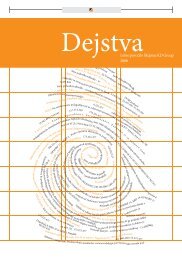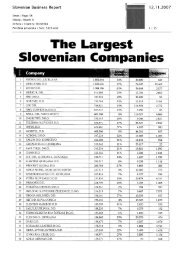The Group KD Group and KD Group dd
The Group KD Group and KD Group dd
The Group KD Group and KD Group dd
You also want an ePaper? Increase the reach of your titles
YUMPU automatically turns print PDFs into web optimized ePapers that Google loves.
<strong>The</strong> <strong>Group</strong> <strong>KD</strong> <strong>Group</strong> Annual Report 2009<br />
Notes to Consolidated Financial Statements as at <strong>and</strong> for the year ended 31 December 2009<br />
5.5 Capital management<br />
Board of Directors takes a decision on maintenance of significant (large) capital scope to ensure the confidence of all<br />
participants <strong>and</strong> development of <strong>KD</strong> <strong>Group</strong>. As one of the strategic indicators, the <strong>Group</strong> defines return on equity as the ratio<br />
between net profit for the year of the majority owner <strong>and</strong> the average value of the majority owner’s equity. <strong>The</strong> <strong>Group</strong> seeks to<br />
keep a balance between large returns which can be reached by higher indebtedness, <strong>and</strong> the advantages <strong>and</strong> safety of a<br />
powerful capital structure. Return on equity is one of the strategic indicators of the <strong>Group</strong>'s annual plan, which is adopted on<br />
the basis of monitoring developments in the environment <strong>and</strong> on maintaining an optimal capital structure. Return on equity is<br />
calculated as the ratio between net profit / loss generated <strong>and</strong> the average value of the total equity, less the value of earnings.<br />
Pursuant to the decision of the General Meeting of Shareholders, the parent company <strong>KD</strong> <strong>Group</strong> d. d. has established its own<br />
share fund. On 31 December 2009 there were 62,201 ordinary shares <strong>KD</strong>HR, which accounts for 2.11% of issued capital <strong>and</strong><br />
51,306 preference shares <strong>KD</strong>HP, which represents 1.74% of issued capital.<br />
<strong>The</strong> investment plan, optimal capital structure policy, expectations <strong>and</strong> interests of shareholders are the basis for<br />
development of the dividend policy. <strong>The</strong> entity distributes dividends once a year. <strong>The</strong> Board of Directors of the parent<br />
company takes a decision about the amount of proposed dividends. Dividends are distributed from the retained earnings of<br />
the parent company, which is regulated in compliance with valid regulations in Slovenia; the decision about dividend<br />
distribution is taken by the General Meeting of Shareholders.<br />
<strong>KD</strong> <strong>Group</strong> d. d. has no specific aims about ownership by employees <strong>and</strong> has no share option programme. In the <strong>Group</strong> there<br />
were no changes in the management of capital in 2009.<br />
<strong>The</strong> parent company is not subject to capital requirements which could be set by the regulatory authority.<br />
For an entity that has subsidiaries in the financial <strong>and</strong> insurance segment, capital requirements are provided by the regulatory<br />
authority. <strong>The</strong> management of the entities provides the proper amount of capital (capital adequacy) according to the scope<br />
<strong>and</strong> type of operations which are managed by the management <strong>and</strong> according to the risks to which they are exposed.<br />
5.6 Fair value of financial assets <strong>and</strong> liabilities<br />
Fair value is the amount for which an asset could be exchanged or a liability settled between knowledgeable, willing parties in<br />
an arm’s length transaction.<br />
<strong>The</strong> <strong>Group</strong> establishes the fair value of financial assets in the following way:<br />
- <strong>The</strong> fair value of investments in equity instruments that have a quoted market price on an active market is determined as<br />
the product of the number of units of the instrument <strong>and</strong> its quoted market price.<br />
- If there is no active market for the financial instruments, methods of assessing the fair value of a financial instrument are<br />
used. Valuation techniques include using recent arm’s length market transactions between knowledgeable, willing<br />
parties, if available, reference to the current fair value of another instrument that is substantially the same, <strong>and</strong><br />
discounted cash flow analysis. <strong>The</strong> <strong>Group</strong> has developed a model for assessing the fair value of non-listed equity<br />
instruments; its appropriateness was assessed by an independent qualified expert. Using this model, the fair values of<br />
significant financial investments in non-listed companies are estimated once a year on the basis of data available.<br />
- <strong>The</strong> fair value of loans <strong>and</strong> deposits represents the discounted amount of estimated future cash flows expected to be<br />
received. Expected cash flows are discounted at current market rates to determine fair value.<br />
- <strong>The</strong> estimated fair value of borrowings not quoted on an active market is based on discounted cash flows using current<br />
market rates. <strong>The</strong> aggregate fair value of quoted debt securities is calculated based on quoted market prices.<br />
- For current receivables <strong>and</strong> liabilities, it is assumed their carrying value reflects their fair value.<br />
- For a contract containing a discretionary participation feature, the fair value cannot be measured reliably.<br />
<strong>The</strong> following table summarises the carrying amounts <strong>and</strong> fair values of those financial assets <strong>and</strong> liabilities not presented on<br />
the <strong>Group</strong>’s balance sheet at their fair value. Bid prices are used to estimate fair values of assets, whereas offer prices are<br />
applied to liabilities.<br />
136







